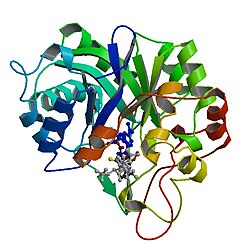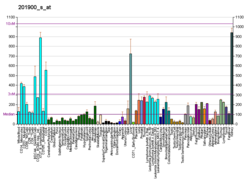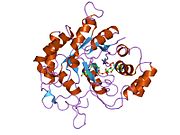Aldo-keto reductase family 1, member A1
Alcohol dehydrogenase [NADP+] also known as aldehyde reductase or aldo-keto reductase family 1 member A1 is an enzyme that in humans is encoded by the AKR1A1 gene.[5][6][7] AKR1A1 belongs to the aldo-keto reductase (AKR) superfamily. It catalyzes the NADPH-dependent reduction of a variety of aromatic and aliphatic aldehydes to their corresponding alcohols and catalyzes the reduction of mevaldate to mevalonic acid and of glyceraldehyde to glycerol.[8] Mutations in the AKR1A1 gene has been found associated with non-Hodgkin's lymphoma.[9]
Structure
Gene
The AKR1A1 gene lies on the chromosome location of 1p34.1 and consists of 10 exons.
Protein
AKR1A1 consists of 325 amino acids and weighs 36573Da. The tertiary structure consists of a beta/alpha-barrel, with the coenzyme-binding site located at the carboxy-terminus end of the strands of the barrel.[10] Alternative splicing of this gene results in two transcript variants encoding the same protein.[7]
Function
AKR1A1 gene is found highly expressed in kidney and liver, and moderately expressed in cerebrum, small intestine and testis. Small amounts of AKR1A1 are present in lung, prostate and spleen. However, it is not observed in heart or skeletal muscle.[11] AKR1A1 belongs to the AKR superfamily, which are predominantly monomeric, soluble, NADPH-dependent oxidoreductases involved in the reduction of aldehydes and ketones into primary and secondary alcohols.[12] AKR1A1 is shown to demonstrate characteristically high specific activity towards many aromatic and aliphatic aldehydes,[11] and preferentially catalyses the NADPH-dependent reduction of aliphatic aldehydes, aromatic aldehydes and biogenic amines.[13][14][15] It is also reported to be involved in the metabolism of 4-hydroxynonenal and play a role in the resistance to oxidative stress.[16]
Clinical significance
A SNP in intron 5 of AKR1A1 has been found to be significantly associated with increased risk of non-Hodgkin's lymphoma.[9] AKR1A1 could activate procarcinogens, such as polycyclic aromatic hydrocarbon.[8] AKRs have been linked to metabolism of the anthracyclines doxorubicin (DOX) and daunorubicin (DAUN), allelic variants showed significantly reduced metabolic activities, and hence these allelic variants can possibly act as genetic biomarkers for the clinical development of DAUN-induced cardiotoxicity.[17]
Interactions
4-hydroxynonenal [16]
polycyclic aromatic hydrocarbon[8]
DAUN [17]
References
- ^ a b c GRCh38: Ensembl release 89: ENSG00000117448 – Ensembl, May 2017
- ^ a b c GRCm38: Ensembl release 89: ENSMUSG00000028692 – Ensembl, May 2017
- ^ "Human PubMed Reference:". National Center for Biotechnology Information, U.S. National Library of Medicine.
- ^ "Mouse PubMed Reference:". National Center for Biotechnology Information, U.S. National Library of Medicine.
- ^ Bohren KM, Bullock B, Wermuth B, Gabbay KH (June 1989). "The aldo-keto reductase superfamily. cDNAs and deduced amino acid sequences of human aldehyde and aldose reductases". The Journal of Biological Chemistry. 264 (16): 9547–51. doi:10.1016/S0021-9258(18)60566-6. PMID 2498333.
- ^ Fujii J, Hamaoka R, Matsumoto A, Fujii T, Yamaguchi Y, Egashira M, Miyoshi O, Niikawa N, Taniguchi N (Jul 1999). "The structural organization of the human aldehyde reductase gene, AKR1A1, and mapping to chromosome 1p33→p32". Cytogenetics and Cell Genetics. 84 (3–4): 230–2. doi:10.1159/000015265. PMID 10393438. S2CID 34254843.
- ^ a b "Entrez Gene: AKR1A1 aldo-keto reductase family 1, member A1 (aldehyde reductase)".
- ^ a b c Palackal NT, Burczynski ME, Harvey RG, Penning TM (January 2001). "Metabolic activation of polycyclic aromatic hydrocarbon trans-dihydrodiols by ubiquitously expressed aldehyde reductase (AKR1A1)". Chemico-Biological Interactions. 130–132 (1–3): 815–24. Bibcode:2001CBI...130..815P. doi:10.1016/s0009-2797(00)00237-4. PMID 11306097.
- ^ a b Lan Q, Zheng T, Shen M, Zhang Y, Wang SS, Zahm SH, Holford TR, Leaderer B, Boyle P, Chanock S (April 2007). "Genetic polymorphisms in the oxidative stress pathway and susceptibility to non-Hodgkin lymphoma". Human Genetics. 121 (2): 161–8. doi:10.1007/s00439-006-0288-9. PMID 17149600. S2CID 11078978.
- ^ El-Kabbani O, Green NC, Lin G, Carson M, Narayana SV, Moore KM, Flynn TG, DeLucas LJ (November 1994). "Structures of human and porcine aldehyde reductase: an enzyme implicated in diabetic complications". Acta Crystallographica Section D. 50 (Pt 6): 859–68. Bibcode:1994AcCrD..50..859E. doi:10.1107/S0907444994005275. PMID 15299353.
- ^ a b O'connor T, Ireland LS, Harrison DJ, Hayes JD (October 1999). "Major differences exist in the function and tissue-specific expression of human aflatoxin B1 aldehyde reductase and the principal human aldo-keto reductase AKR1 family members". The Biochemical Journal. 343 Pt 2 (2): 487–504. doi:10.1042/bj3430487. PMC 1220579. PMID 10510318.
- ^ Penning TM, Drury JE (August 2007). "Human aldo-keto reductases: Function, gene regulation, and single nucleotide polymorphisms". Archives of Biochemistry and Biophysics. 464 (2): 241–50. doi:10.1016/j.abb.2007.04.024. PMC 2025677. PMID 17537398.
- ^ Feather MS, Flynn TG, Munro KA, Kubiseski TJ, Walton DJ (May 1995). "Catalysis of reduction of carbohydrate 2-oxoaldehydes (osones) by mammalian aldose reductase and aldehyde reductase". Biochimica et Biophysica Acta (BBA) - General Subjects. 1244 (1): 10–6. doi:10.1016/0304-4165(94)00156-r. PMID 7766643.
- ^ Bohren KM, Page JL, Shankar R, Henry SP, Gabbay KH (December 1991). "Expression of human aldose and aldehyde reductases. Site-directed mutagenesis of a critical lysine 262". The Journal of Biological Chemistry. 266 (35): 24031–7. doi:10.1016/S0021-9258(18)54387-8. PMID 1748675.
- ^ Petrash JM, Srivastava SK (September 1982). "Purification and properties of human liver aldehyde reductases". Biochimica et Biophysica Acta (BBA) - Protein Structure and Molecular Enzymology. 707 (1): 105–14. doi:10.1016/0167-4838(82)90402-2. PMID 6753936.
- ^ a b Li D, Zhang Q, Zhou L, Liu R (March 2013). "[Effect of AKR1A1 knock-down on H2;O2; and 4-hydroxynonenal-induced cytotoxicity in human 1321N1 astrocytoma cells]". Xi Bao Yu Fen Zi Mian Yi Xue Za Zhi = Chinese Journal of Cellular and Molecular Immunology. 29 (3): 273–6. PMID 23643085.
- ^ a b Bains OS, Takahashi RH, Pfeifer TA, Grigliatti TA, Reid RE, Riggs KW (May 2008). "Two allelic variants of aldo-keto reductase 1A1 exhibit reduced in vitro metabolism of daunorubicin". Drug Metabolism and Disposition. 36 (5): 904–10. doi:10.1124/dmd.107.018895. PMID 18276838. S2CID 14214962.
Further reading
- Dawson SJ, White LA (May 1992). "Treatment of Haemophilus aphrophilus endocarditis with ciprofloxacin". The Journal of Infection. 24 (3): 317–20. doi:10.1016/S0163-4453(05)80037-4. PMID 1602151.
- Tanimoto T, Ohta M, Tanaka A, Ikemoto I, Machida T (1991). "Purification and characterization of human testis aldose and aldehyde reductase". The International Journal of Biochemistry. 23 (4): 421–8. doi:10.1016/0020-711X(91)90169-N. PMID 1901806.
- Vander Jagt DL, Hunsaker LA, Robinson B, Stangebye LA, Deck LM (July 1990). "Aldehyde and aldose reductases from human placenta. Heterogeneous expression of multiple enzyme forms". The Journal of Biological Chemistry. 265 (19): 10912–8. doi:10.1016/S0021-9258(19)38533-3. PMID 2113526.
- Wermuth B, Omar A, Forster A, di Francesco C, Wolf M, von Wartburg JP, Bullock B, Gabbay KH (1987). "Primary structure of aldehyde reductase from human liver". Progress in Clinical and Biological Research. 232: 297–307. PMID 3615425.
- Barski OA, Gabbay KH, Grimshaw CE, Bohren KM (September 1995). "Mechanism of human aldehyde reductase: characterization of the active site pocket". Biochemistry. 34 (35): 11264–75. doi:10.1021/bi00035a036. PMID 7669785.
- Takahashi M, Lu YB, Myint T, Fujii J, Wada Y, Taniguchi N (January 1995). "In vivo glycation of aldehyde reductase, a major 3-deoxyglucosone reducing enzyme: identification of glycation sites" (PDF). Biochemistry. 34 (4): 1433–8. doi:10.1021/bi00004a038. PMID 7827091.
- Robinson B, Hunsaker LA, Stangebye LA, Vander Jagt DL (December 1993). "Aldose and aldehyde reductases from human kidney cortex and medulla". Biochimica et Biophysica Acta (BBA) - Protein Structure and Molecular Enzymology. 1203 (2): 260–6. doi:10.1016/0167-4838(93)90092-6. PMID 8268209.
- Sato S, Lin LR, Reddy VN, Kador PF (August 1993). "Aldose reductase in human retinal pigment epithelial cells". Experimental Eye Research. 57 (2): 235–41. doi:10.1006/exer.1993.1119. PMID 8405190.
- Udovikova EA, Wojtczak L (May 1998). "Mitochondrial aldehyde reductase: identification and characterization in rat liver and kidney cortex". The International Journal of Biochemistry & Cell Biology. 30 (5): 597–608. doi:10.1016/S1357-2725(97)00143-X. PMID 9693960.
- Barski OA, Gabbay KH, Bohren KM (September 1999). "Characterization of the human aldehyde reductase gene and promoter". Genomics. 60 (2): 188–98. doi:10.1006/geno.1999.5915. PMID 10486210.
- O'connor T, Ireland LS, Harrison DJ, Hayes JD (October 1999). "Major differences exist in the function and tissue-specific expression of human aflatoxin B1 aldehyde reductase and the principal human aldo-keto reductase AKR1 family members". The Biochemical Journal. 343 Pt 2 (2): 487–504. doi:10.1042/bj3430487. PMC 1220579. PMID 10510318.
- Picklo MJ, Olson SJ, Markesbery WR, Montine TJ (July 2001). "Expression and activities of aldo-keto oxidoreductases in Alzheimer disease". Journal of Neuropathology and Experimental Neurology. 60 (7): 686–95. doi:10.1093/jnen/60.7.686. PMID 11444797.
- Laclau M, Lu F, MacDonald MJ (September 2001). "Enzymes in pancreatic islets that use NADP(H) as a cofactor including evidence for a plasma membrane aldehyde reductase". Molecular and Cellular Biochemistry. 225 (1–): 151–60. doi:10.1023/A:1012238709063. PMID 11716357. S2CID 38935230.
- Lehner B, Sanderson CM (July 2004). "A protein interaction framework for human mRNA degradation". Genome Research. 14 (7): 1315–23. doi:10.1101/gr.2122004. PMC 442147. PMID 15231747.
- El-Kabbani O, Green NC, Lin G, Carson M, Narayana SV, Moore KM, Flynn TG, DeLucas LJ (November 1994). "Structures of human and porcine aldehyde reductase: an enzyme implicated in diabetic complications". Acta Crystallographica Section D. 50 (Pt 6): 859–68. Bibcode:1994AcCrD..50..859E. doi:10.1107/S0907444994005275. PMID 15299353.
- Bohren KM, Brownlee JM, Milne AC, Gabbay KH, Harrison DH (May 2005). "The structure of Apo R268A human aldose reductase: hinges and latches that control the kinetic mechanism". Biochimica et Biophysica Acta (BBA) - Proteins and Proteomics. 1748 (2): 201–12. doi:10.1016/j.bbapap.2005.01.006. PMID 15769597.
External links
- AKR1A1 human gene location in the UCSC Genome Browser.
- AKR1A1 human gene details in the UCSC Genome Browser.










